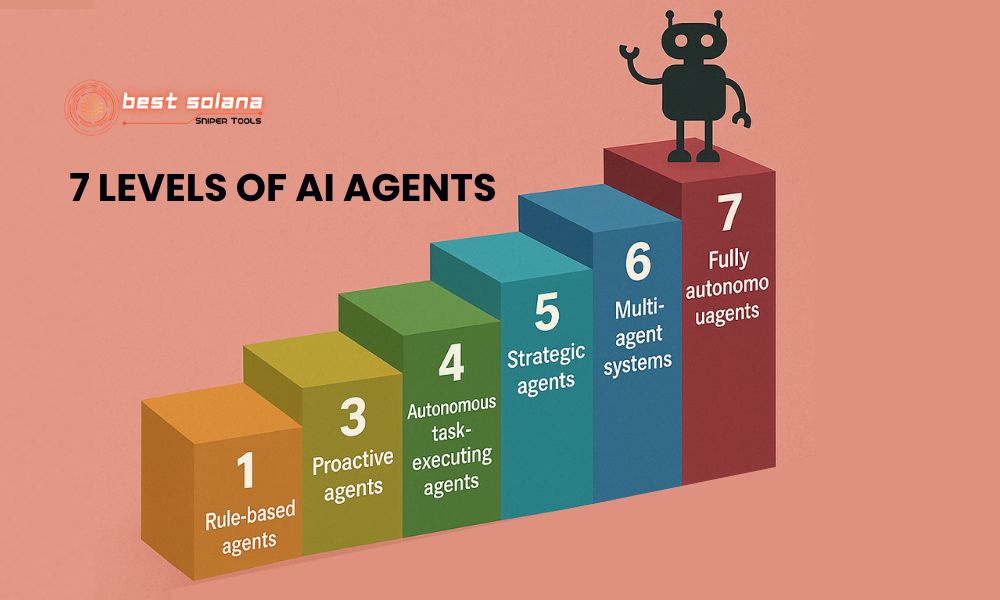The 7 levels of AI agents offer a critical framework for envisioning the future of technology, a future where artificial intelligence not only executes commands but also acts autonomously. Understanding each stage of this evolution unlocks opportunities for individuals and businesses to apply and prepare for the coming technological revolution, making it a vital concept to grasp.
What is an AI agent?
Before we explore the 7 levels of AI agents, it’s essential to understand the core concept. An AI agent is more than just a chatbot or an automation script. It is an autonomous system capable of perceiving its environment through sensors (input data), making its own decisions to achieve a specific goal, and taking actions within that environment.
Fundamentally, an AI agent consists of three main components:
- Perception: Gathering information from the environment.
- Decision-making: Processing information and choosing the optimal action.
- Action: Executing the decision within the environment.
The key difference between the various levels of AI agents lies in the complexity and autonomy of these three components.
Exploring the 7 levels of AI agents
This classification framework helps us visualize the development path from the simplest systems to the fully autonomous agents of the future. Understanding this progression is key, so let’s explore the 7 levels of AI agents in detail.

Level 1: Rule-based agents
This is the most basic level. These agents operate based on a pre-programmed set of “if-then” rules. They have no ability to learn or adapt to situations that fall outside of these rules.
Characteristics: Rigid operation, only handles predefined scenarios.
Example: Automated website chatbots that can only respond to questions in their script, or a simple thermostat that turns on or off when a certain temperature threshold is reached.
Level 2: Context-aware agents
Agents at this level can understand the basic context of a request. They can use information about time, location, or past interaction history to provide a more relevant response.
Characteristics: Understands simple context, provides more flexible responses.
Example: A virtual assistant like Siri or Google assistant that can understand the command “remind me to call mom when I get home” by combining information about “mom” in your contacts and your phone’s GPS data.
Level 3: Proactive agents
This is a major step forward. Instead of just waiting for commands, these agents can proactively make suggestions or take actions based on data analysis and predicting user needs.
Characteristics: Capable of suggesting and recommending actions.
Example: Google maps proactively suggesting a faster route when it detects traffic congestion, or Spotify automatically creating a “discover weekly” playlist based on your listening habits.
Level 4: Autonomous task-executing agents
At this level, an agent can independently complete a complex, multi-step task without human intervention. The user only needs to issue a high-level command, and the agent will figure out how to execute it. This level marks a significant jump within the 7 levels of AI agents.
Characteristics: Automates multi-step processes.
Example: An AI travel agent that can book flights, hotels, and a rental car from a single request like “plan a 3-day trip to London for the end of the month.”
Level 5: Strategic agents
These agents not only execute tasks but also have the ability to set their own sub-goals to achieve a larger, long-term objective. They can plan, allocate resources, and adjust their strategy flexibly.
Characteristics: Capable of strategic planning and optimization.
Example: An AI investment portfolio manager that automatically buys and sells stocks to achieve a 15% annual return target, or a supply chain agent that automatically coordinates goods to optimize cost and time.
Level 6: Multi-agent systems
This level involves multiple individual AI agents that can communicate, coordinate, and negotiate with each other to solve a common problem that a single agent could not.
Characteristics: Collaborative, coordinated, and socially interactive.
Example: A fleet of self-driving cars coordinating with each other to optimize traffic flow, or a network of delivery drones sharing information to avoid collisions and choose the most efficient routes.
Level 7: Fully autonomous agents
This is the highest and still largely theoretical level, closely aligned with the concept of artificial general intelligence (AGI). These agents would possess human-level or greater abilities in perception, reasoning, creativity, and learning. They could define their own goals and operate completely independently.
Characteristics: Creative, potentially conscious, and fully autonomous.
Example: An AI capable of running an entire business, from developing new products and creating marketing strategies to managing finances.
In summary, the 7 levels of AI agents outline a clear trajectory from simple automation to fully autonomous intelligence. This is a revolution happening day by day. To ensure you don’t miss the latest insights on technology and AI, make sure to follow Best Solana Sniper.
